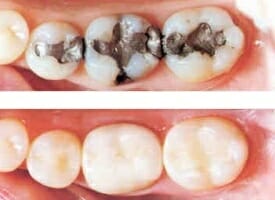Crowns and fillings are both effective treatments used to save teeth that have 
Of course, a dental exam is necessary to determine which treatment will be best, but here are a few factors our dentists consider.
When are Fillings Used?
If a tooth has only minor decay, a filling is usually the best choice. A filling becomes necessary when a cavity develops; the decayed tooth matter must be removed in order to restore the health of the tooth. In addition, a tooth that has suffered significant wear may benefit from a filling.
Getting a filling is typically a simple procedure. The decayed tooth matter is removed and then a material – usually silver amalgam, ceramic, porcelain, or tooth-colored composite – is used to fill in the spaces. For many patients with cavities, fillings will be the proper treatment.
When are Crowns Used?
Crowns are used to provide strength and stability to a weakened tooth. A tooth that has become vulnerable due to decay may not be able to support a filling, in which case it can be covered with a crown.
 If a decayed tooth has cracked or broken, the dentist will likely recommend a crown to avoid extracting the tooth and instead preserve as much tooth structure as possible.
If a decayed tooth has cracked or broken, the dentist will likely recommend a crown to avoid extracting the tooth and instead preserve as much tooth structure as possible.
In addition, a crown is usually placed after a root canal to ensure the tooth has the strength to stand up to chewing.
To place a crown on a decayed tooth, one of our dentists will usually utilize filling material to create a larger and more ideal surface for the crown. Then, the crown is cemented to the tooth.
In short, the right treatment will depend heavily on the patient’s individual case. Patients who are experiencing cavity-like symptoms should call our dentists as soon as possible for best results.

